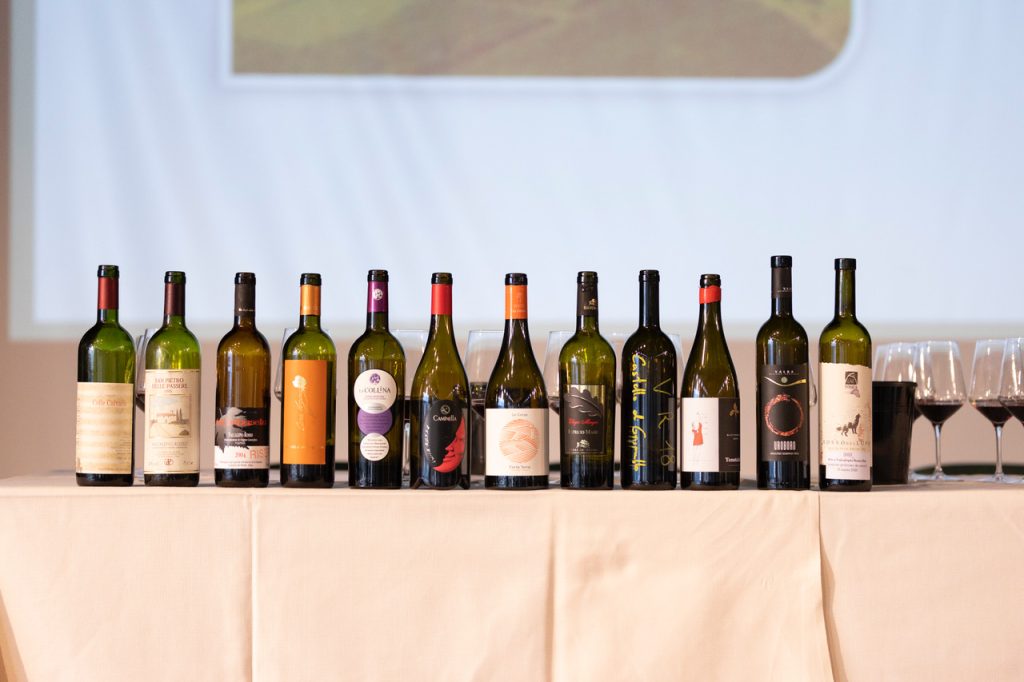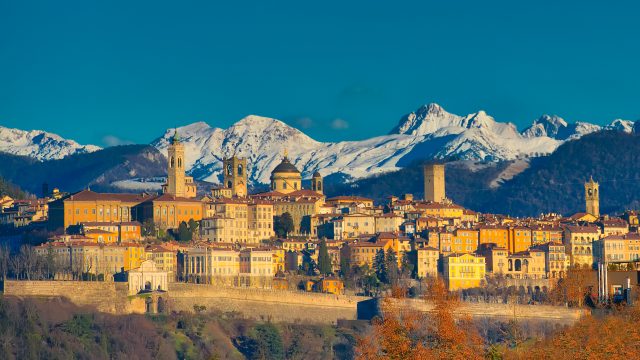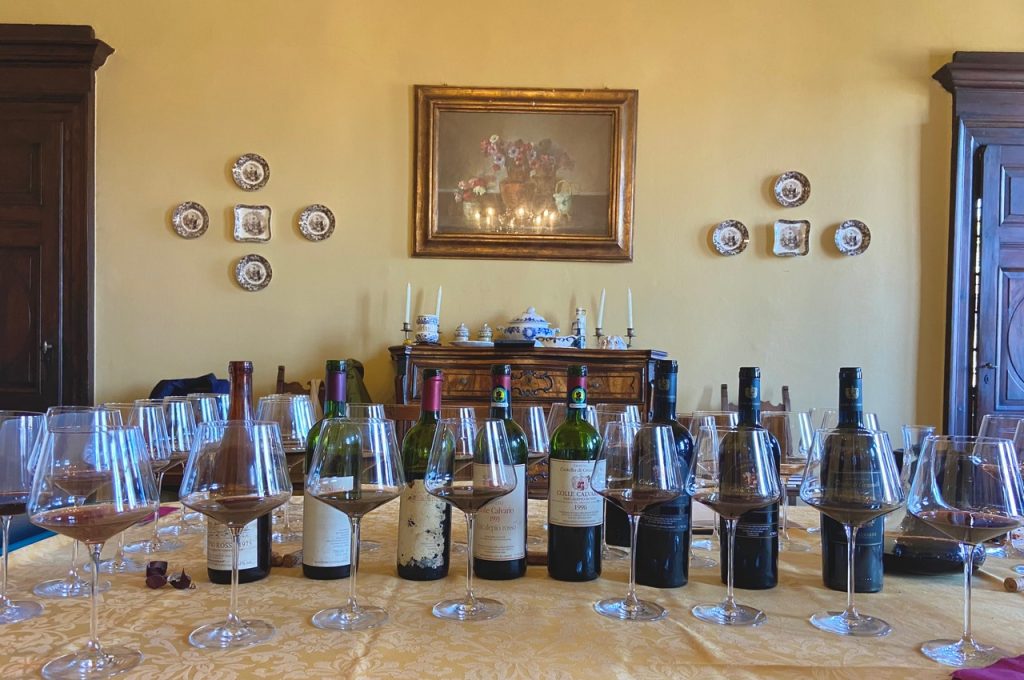This website uses cookies so that we can provide you with the best user experience possible. Cookie information is stored in your browser and performs functions such as recognising you when you return to our website and helping our team to understand which sections of the website you find most interesting and useful.
Bergamo: Bordeaux-style wines and the invention of Bordeaux mixture
Have you heard of the wines of Bergamo? Don’t worry, most wine people don’t. But why is that? How has such an ancient wine region become silent and are the wines any good today?

With this question in mind, I decided to take a trip to Barra (the ancient name of Bergamo) where during the Roman period luscious vines surrounded the city. During the 6th century, the Lombards were intensely involved with wine making here and original documents also show the importance of the wine industry between the 12th and the 15th century.
A lot of local varieties are mentioned in those documents: Vernacce, Groppelle, Marzoline and Trebbiane, while by the 1700’s other varieties such as Schiava, Merera and Moscatella had become the most important varieties, with wine being produced in abundance.
However, all of this changed around the mid 1800’s – and it you are thinking this was because of the vine’s most dangerous nemesis, Phylloxera, you are wrong. Obviously the nasty bug killed a lot of vines but the biggest enemy for the vineyards in Bergamo was the mulberry tree, used to raise silkworms, which started to replace more and more vineyards.
Around this time, documents state that Bergamo Alta had 20,000 inhabitants, 1,300 hectares of vines and 90 osterie (restaurants). This vineyard remained intact up to 1929, as a land register shows the city and its surrounding had around 1,100 hectares planted with these varieties, alongside Bonarda, Negrara and Imberghem.
This latter is the Franconia variety and, together with Merera, are the two only indigenous red varieties left, usually bringing a lot of colour, acidity and structure to the wines.
For while the silk industry was becoming the new business opportunity, a new era for wine started when Prince Gonzaga del Carretto brought a new French variety called ‘Burdinì’, aka Cabernet Sauvignon to the region in 1850. This was the start of Bergamo’s Bordeaux-style blend which would become its signature.
However, while France might have given Bergamo its new vines, Bergamo gave France and the rest of the wine world an amazing and very important innovation.
In 1874, Professor Giacomo Soncini, dean at the Agronomic school of Grumello, made a revolutionary scientific discovery that would change the history of vineyard treatments: the ability of copper ion to stop the germination of spores in downy mildew. In 1885, this discovery translated into the famous ‘Bordeaux mixture’ – a mixture of copper sulphate and quicklime used as a fungicide.
Many years have passed since then, and during Italy’s industrial revolution, the region became one of the country’s most important engines of the new economy. And although Italy still didn’t have an appellation system, in 1962 wine maker Carlo Zadra gave birth to the first new Bordeaux blend at the cooperative winery San Paolo d’Argon. Called Tre Valli, it was made from Cabernet Sauvignon from the Calvario hills and Merlot from Torre dei Roveri area. The wine was an immediate success and led most farmers to plant Bordeaux varieties and later, in 1976, the creation of the new appellation Valcalepio DOC (Merlot 40% – 75% – Cabernet Sauvignon 25% – 60%).
Since 2011, the area has acquired the appellations of Colleoni DOC, which focuses on mono-varietal wines, and the IGT Bergamo, which is customarily used by those producers who want to work with different percentages of varieties in their wines.
The only question that remains is: are the wines any good?
During my research studies, I had the opportunity to try the wines from a dozen wineries going back to 1978 and although some were over-the-top extractive reds, others were a some stunning surprise.
The Production area

The borders of the appellation are the Prealps Orobie to the North with Valtellina and Alpi Retiche further north bringing some serious cold winds and mountain climatic conditions. Viticulture takes place between 200 and 600m above sea level, around five valleys stretching for about 45 kilometres.
On the eastern side is the border of the appellation with Lake Iseo (behind the lake is the famous Franciacorta sparkling wine region), where the vineyards are on a more sandstone-based soil with traces of calcareous and marl composition. The wines tend to be well-structured and fine. The valleys comprise:
- Val Camonica
- Val Cavallina (called the cold valley)
- Val Seriana
On the western side, the vineyards tend to be more mountainous with a marl/schist rocky soil, producing more red fruit driven and reactive style reds. The valleys are:
- Val Brembana
- Valle Imagna (famous for the delicious Taleggio cheese)
- The border to the Western side is the Adda river and lake Como.
The total hectares are around 700 with 60% of Merlot and Cabernet Sauvignon plus other white and red varieties, including the Moscato di Scanzo for the homonymous sweet DOCG appellation.
The Verdict
Having tasted roughly 50 samples, the following are some of the most representative of the different styles.
On the one hand, there is a group of wines which show the vibrant red fruit and mineral quality of a cool climate region which Valcalepio actually is. In this group I found wines with a higher degree of transparency as a result with more sense of place: the voice of terroir I think is louder when there’s less forced concentration of the fruit.
On the other hand there’s a group of wines with a rounder, sweeter, bigger and more voluminous attitude given either by withering (just like in the case of Amarone). These wines seem to be destined to a larger crowd and of course with a more commercial and palate-pleasing attitude the prior group.
Clearly there’s an identity crisis which isn’t about to be cleared up soon, because in the wine world any decision taken usually shows the result only after a few years.
My feeling though is that the ‘transparent driven’ producers seems to be more convinced of the avenue they have chosen, while the majority of the ‘bigger and bolder’ producers are less sure – even if most of them might like to tune down the withering, they are afraid of how the market would react to a change in style.
It is going to take some time before the wines of Bergamo will be able to have an en primeur event with bottles all from the same vintage and with a similar production code, but choosing a common avenue is the only way forward to create a strong and united
image.

The Wines
Valcalepio Rosso VT 1975 Castello di Grumello
Tea tree oil, ripe medlar, blueberries and cedar wood with an iodine whiff and an uplifting hint of suede lather. The palate of this Merlot/Cabernet Sauvignon is agile, vibrant with so much salinity and a juicy energy which delivers more flavours of oranges, wild roses and a contrasted slightly scratchy but uplifting Neil Young “Dead man” guitar strumming with a very much alive finish!
A beautiful property under new ownership – Angelo and Daniele Gotti – and an MD, Stefano Lorenzi, who is also one of Italy’s leading expert on agroforestry. I tasted all the wines all the way up to 2021 and the consistency is overwhelming.
San Pietro delle Passere, Valcalepio Rosso Doc 1995 – Pecis
Liquorice, shiitake mushrooms, anise and black currants.
The palate is balsamic with sweet roots and cardamom. Green pepper, incense and tobacco with a delicious earthy and umeboshi finish for this light bodied (only 12%) and old school Bordeaux blend.
The wines come from a tiny five hectares estate, next to a monastery that was built in 1079. The owner, Angelo, is an engineer with a passion for wine. Started in 1983, today Angelo is one of the believers in Franconia to bring that indigenous refreshing character to the Bergamo Bordeaux blend.
Valcalepio Doc Rosso Riserva 2004 – La Cornasella
Warm spicy notes, macerated red fruit, hints of oak. Coconut, blueberries, and tobacco. This is a more extractive style with a lot of prunes and ripe black fruit and a very body builder like character. The palate is reflecting the aromas on the nose, and it ends with a balsamic sweet finish.
A small winery owned by the Gavazzini Family near Grumello del Monte with 3.5 hectares. Its very young and determined winemaker, Angelo Peretti, is working hard on highlighting not only Valcalepio wines but also Moscato di Scanzo vinified sweet, dry white wines.
Drago di Santa Brigida, IGT Bergamasca 2010 – Tenuta Casa Virginia
60% Merlot, 40% Cabernet Sauvignon aged for 18 months in barriques.
Eucalyptus, red berries, goji berries, anise and light oak spices. On the palate the wine flies like Perseus with its winged sandals, delivering a massive amount of vibrant and super drinkable juicy freshness of propolis, bergamot and nori.
16 different parcels located on a marl-based soil. A professional cook, a restauranteur, a winemaker and I would add a philosopher. Two hectares only run with a lot of dedication and a garage-wine cellar where never a hint of new oak is present in the wines.
Rossa Passione, Valcalepio Rosso Doc 2013 – La Collina
Cabernet based blend with some Merlot and a dash of Petit Verdot. A very extractive and overripe style of nose reminiscent o prunes, black cherry marmalade, chocolate and coconut. The palate is absolutely reflecting the nose, amplifying the black driven fruit, the balsamic and menthol character of the wine and a sweet rich finish.
A family run winery solely dedicated to wine making for generations. The idea here is to get the Cabernet Sauvignon macerate a little longer to get an extra level of ripeness almost to obtain more glycerol, roundness and sweetness.
Luna Rossa, IGT Bergamasca Rosso 2014 – Caminella
Hints of tea and orange with some blackberries, moka coffee, chocolate and blueberries. Toasted almond, oak spices, tobacco and leather. A very densely structure and powerful red despite the very rainy vintage.
A beautiful winery built under the mountain in the calcareous-marl soil which takes locally the name of ‘Sass del Luna’ (the moon stone). 50% Merlot, 45% Cabernet Sauvignon, dried in the loft for over a month and 5% Pinot Noir.
Forte Terra, Valcalepio Doc Rosso 2017 – Le Corne
Light tannic structure for this ‘petite wine‘ of the Tenuta Le Corne. Less ambitions then the top of the line but with a great reactiveness and supple red fruit.
There’s a good energy, some gun flint style minerality and lovely balsamic and menthol and cherries flavours on the finish.
A 30 ha estate mainly with Merlot and Cabernet Sauvignon which are vinified separately in what probably -has to be- the most modern state of the art cellar fin Valcalepio.
‘Patrizio Magri’, IGT Bergamasca Rosso 2017 – Eligio Magri
Plums, medicinal herbs, Fernet and after eight style notes. Very ripe, very black driven fruit and prunes style nose with a hint of liquorice and a touch of balsamic edge and a residual sugar which makes the wine pretty approachable despite the big structure.
Late harvest style Cabernet Sauvignon and Merlot with a modern vinification in inox, 3 years fining in the steel tanks and over a year of French and American oak barrels. The vines are cultivated in the historical Torre dei Roveri site.
Mastrorigo Igt Bergamasca 2019 – Tenuta Iris
Deep purple colour and “deep purple” hard rock attitude! Ripe red fruit, mulberries, black cherries and gun flint. Tobacco and leather with a green and black pepper note and some blue flowers. Powerful and rich but also with a good juicy edge.
From 2.5 ha on Sarnico sandstone soil this explosive wine is produced by a talented young wine maker who’s started only in 2018! Kudos for the passion and the already promising results.
Uroboro Rosso, IGT Bergamasca 2020 – Valba
Garnet colour with dark fruit, smoky and slightly toasted notes of coffee, vanilla and sweet oak spices. Powerful structure and mature fruit for this full bodied wine packed with prunes and Christmas pudding notes on the finish.
The estate comprises 2.5ha of very old vineyards on a very steep slope at the foothills of the cold Monte Misma. Sandstone and clay soil and a relatively cooler climate could be the reason why the grapes dry 20 days in the cellar before the fermentation.
Rosso del Lupo, Valcalepio Doc Rosso 2021 – Tosca
Ruby colour, very deep and bright. The nose is an explosion of wild strawberry, rosehip, hibiscus, sour cherries and floral notes. The palate is fresh, with some pepperiness and a lot of rebury crush and a delightful minerality a crispy finish. Still young, needs time.
From the higher altitudes of the far west Pontida area, this vegan friendly and family run winery is one to watch as, Romildo, the wine maker, seems very determined to focus on the purest fruit of the area.
Related news
InterContinental Singapore launches Champagne drive-through
A 'challenging yet surprising' vintage for Centre-Loire in 2024

